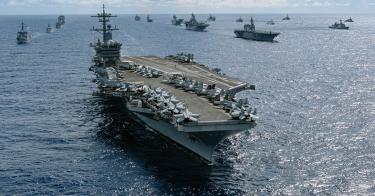According to CIA Director William Burns, Chinese President Xi Jinping has ordered his army to be ready to conduct a successful invasion of Taiwan by 2027. And preparing they are. On April 10, for example, Beijing dispatched a record-breaking 91 military aircraft to fly threateningly toward Taiwan. More than half of the jets crossed the de facto demarcation line, violating Taiwanese airspace.
So, what will the U.S. do to prepare to meet this threat? The Biden administration, it seems, still underestimates the danger.
At Senate and House congressional hearings held April 18, the heads of the Indo-Pacific Command and the Navy failed to convincingly articulate plans that meet the rapidly spreading China threat.
A main focus of the hearings was the Navy’s congressionally required long-range shipbuilding plan, released just last week. The plan provides three options, none of them good and all likely illegal.
>>> Navy’s Next Destroyer Is Vital as U.S.–China Tensions Escalate
All three options are seriously anemic. Since the Navy and the White House have failed to provide a viable plan to defend American interests, Congress must proceed to devise its own.
The administration’s plans grossly understate how many new ships will be needed to ensure our security. Meanwhile, they are bent on accelerating the retirement of warships with service life still remaining while deferring hard choices on how to increase our woefully inadequate capacity for shipbuilding and maintenance.
Administration officials seem to want it both ways. They are quick to acknowledge the urgency of the China threat but reluctant to recommend the tough and inevitably expensive choices needed to meet that threat.
At the April 18 Senate meeting, the Indo-Pacific commander and a senior rep from the secretary of defense reiterated the pace and danger of the growing China threat. Yet none of the options in the administration’s plan calls for amassing a fleet of 31 large amphibious warships — something it has been directed to do by Congress. Among others, Sen. Dan Sullivan, Alaska Republican, called out the Navy for this blatant disregard of Congress.
Given the administration’s failure to perform, Congress must step up to the plate and devise its own plan, one that will meet these objectives:
- Increase the fleet to 355 warships well before the administration’s proposed target date of 2042. Most experts believe China sees its maximum opportunity to attack as coming this decade. We must be ready then, not 20 years from now.
- Ensure the U.S. retains its dominance in the undersea domain. Our nuclear submarines and the associated long-range strike capacity are critical to deterring Chinese aggression. We currently hold an advantage in this domain, but a precipitous decline is looming. The administration’s plan fails to secure this advantage, much less tackle the need to grow its firepower.
- Address the need to rapidly increase the number of small, multi-mission-capable ships. Currently, those numbers are declining. The Navy’s last purchase of the Littoral combat ship came in fiscal 2019. Frigate construction is just beginning; the ships will not be ready for action until at least September 2026.
- Reverse the most feckless element of the administration’s long-range shipbuilding plan: its proposal to actually shrink the Navy over the next five years. That’s the same period in which the danger of war may be at its greatest, according to the testimony of top U.S. military officials. Congress must reject this downsizing and, instead, pursue options that will maximize the availability of ships and crews this decade.
- Halt the decommissioning of ships with service life left. As many as 14 ships listed for decommissioning have service life left. Rather than consign them to the scrapheap, Congress should have these ships put into mothball. This would allow them to be returned to service, should world events dictate. Returning mothballed ships to service helped turn the tide of the Korean War and kick-started Ronald Reagan’s 600-ship buildup.
>>> Navy Dry Dock Closures Make a Bad Problem Worse
This is not an exhaustive list of what needs to be fixed in the administration’s shipbuilding plan. For example, it fails to address the current eight-ship shortfall in sealift and the military’s increasing need for fuel tankers. The latter problem will only worsen, given the closing of the massive Red Hill bulk fuel storage facility in Oahu, Hawaii. Tankers will be in bigger demand to move fuel and will have to travel further to service a fleet dispersed across the Indo-Pacific.
For a fleet already struggling with questionable preparedness, the administration’s long-range shipbuilding plan is nothing short of indefensible. Congress, once again, is left to act. It must carry out its constitutional responsibility to provide and maintain the Navy required for national defense.
This piece originally appeared in The Washington Times




